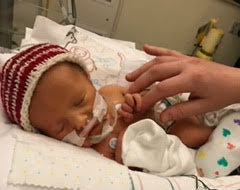Condition
Duodenal Atresia or Stenosis in Infants
The duodenum is the first portion of the small intestine that follows the stomach. Duodenal atresia or stenosis occurs when the intestine does not develop normally and leads to a blockage in the continuity of the intestine. The incidence of duodenal atresia or stenosis in infants occurs in 1 in 6,000 births and is seen more frequently in infants with Down's syndrome or Trisomy 21.
How is duodenal atresia or stenosis diagnosed in infants?
Most cases of duodenal atresia are diagnosed on prenatal ultrasound which reveals polyhydramnios (extra fluid in the amniotic sac) and a dilated fluid filled stomach. At birth, infants may have vomiting with inability to feed.
What is the treatment for duodenal atresia or stenosis in infants?
Duodenal atresia or stenosis is treated surgically. A new connection between the upper duodenum and distal duodenum must be created to bypass the blockage. The operation may be performed either through an upper abdominal transverse incision, by minimally invasive surgery, or laparoscopy using small incisions which become barely visible with age. Other advantages of minimally invasive procedures in infants include less pain, less scarring, shorter hospital stays and fewer problems with scar tissue leading to intestinal blockages in the future compared to open abdominal surgery.
Children's National Hospital offers both treatment options and assess with families to determine the best care plan for each individual patient.
Schedule an Appointment
Our pediatric specialists provide personalized care for your child’s physical, mental and emotional health needs. Meet our providers and schedule an appointment today.
Meet the Providers Who Treat Duodenal Atresia or Stenosis in Infants
Departments that Treat Duodenal Atresia or Stenosis in Infants

Neonatology
Whether your infant has arrived prematurely or has a critical illness, the top-ranked neonatology team at Children's National Hospital assists in coordinating every service you and your baby need, including consultations, assessments, emergency treatments and continuing care.

Help Kids and Make a Difference
Invest in future cures for some of life's most devastating diseases. Give today to help more children grow up stronger.









